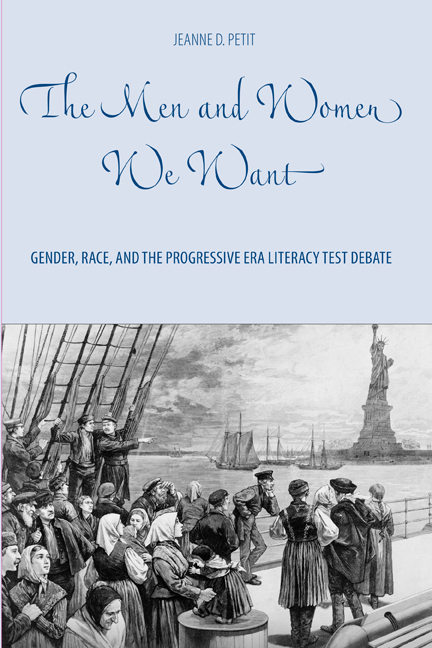Book contents
- Frontmatter
- Dedication
- Contents
- List of Illustrations
- Acknowledgments
- Introduction
- 1 Breeders, Workers, and Mothers: The Beginning of the Literacy Test Debate
- 2 Parents and Progeny: The Dillingham Commission Report
- 3 Muscle, Miscegenation, and Manhood: The Literacy Test at the Height of the Progressive Era
- 4 Practical Aid and Sympathetic Understanding: Grace Abbott's Alternative to the Literacy Test
- 5 World War I and the Literacy Test
- 6 The Legacy of the Progressive Era Literacy Test Debate
- Notes
- Bibliography
- Index
3 - Muscle, Miscegenation, and Manhood: The Literacy Test at the Height of the Progressive Era
Published online by Cambridge University Press: 14 March 2018
- Frontmatter
- Dedication
- Contents
- List of Illustrations
- Acknowledgments
- Introduction
- 1 Breeders, Workers, and Mothers: The Beginning of the Literacy Test Debate
- 2 Parents and Progeny: The Dillingham Commission Report
- 3 Muscle, Miscegenation, and Manhood: The Literacy Test at the Height of the Progressive Era
- 4 Practical Aid and Sympathetic Understanding: Grace Abbott's Alternative to the Literacy Test
- 5 World War I and the Literacy Test
- 6 The Legacy of the Progressive Era Literacy Test Debate
- Notes
- Bibliography
- Index
Summary
By early 1912, literacy test legislation was front and center in the American political landscape, and the men of the Immigration Restriction League (IRL) were delighted. After the Dillingham Commission's findings, they believed that a literacy test was just around the corner. At long last, the nation would be protected from weak and dependent immigrants dragging it down. The year 1912, however, was also a time when interest groups from across the political spectrum felt empowered to participate in debates about the scope of government power and the role of immigrants in American life. Thus, even after the Dillingham Commission validated its call for a literacy test, the IRL faced more intense opposition than ever. One group that aggressively entered the fight in 1912 was the American Association of Foreign Language Newspapers (AAFLN), a group of foreign- and native-born men who became fierce opponents of the literacy test. Yet the AAFLN combated the arguments of the IRL on the IRL's own terms by linking the desirability of southeastern European immigrant races to the manliness of those who belonged to them.
On January 11, 1912, Louis Hammerling, the charismatic president of the AAFLN, brought a group of his Association's editors to testify before the House Committee on Immigration and Naturalization. They spoke out against HR 22527, an immigration bill that included a literacy test for restriction of immigration. Hammerling declared that he and the men of his organization attended the hearings to “protest against any new laws that would prohibit desirable and worthy immigrants from entering this country.” The desirability of immigrants, according to Hammerling, was proven by the work they did once they arrived in the U.S. “The prosperity and development of the nation is due to the sturdy immigrants we have received during the last 30 years,” he asserted. Then he warned congressmen that “if you gentlemen were to pass the educational test today we would be deprived of the men we need.”
- Type
- Chapter
- Information
- The Men and Women We WantGender, Race, and the Progressive Era Literacy Test Debate, pp. 59 - 86Publisher: Boydell & BrewerPrint publication year: 2010

